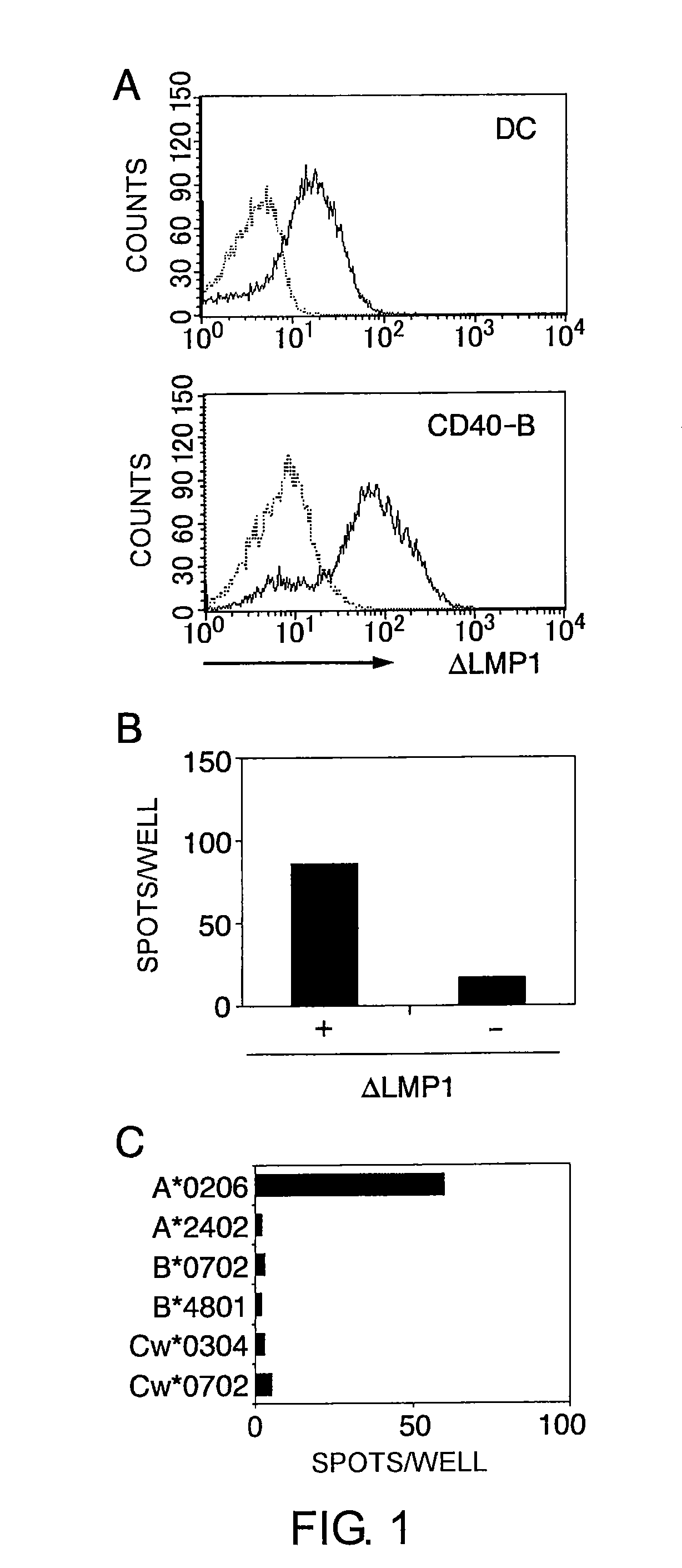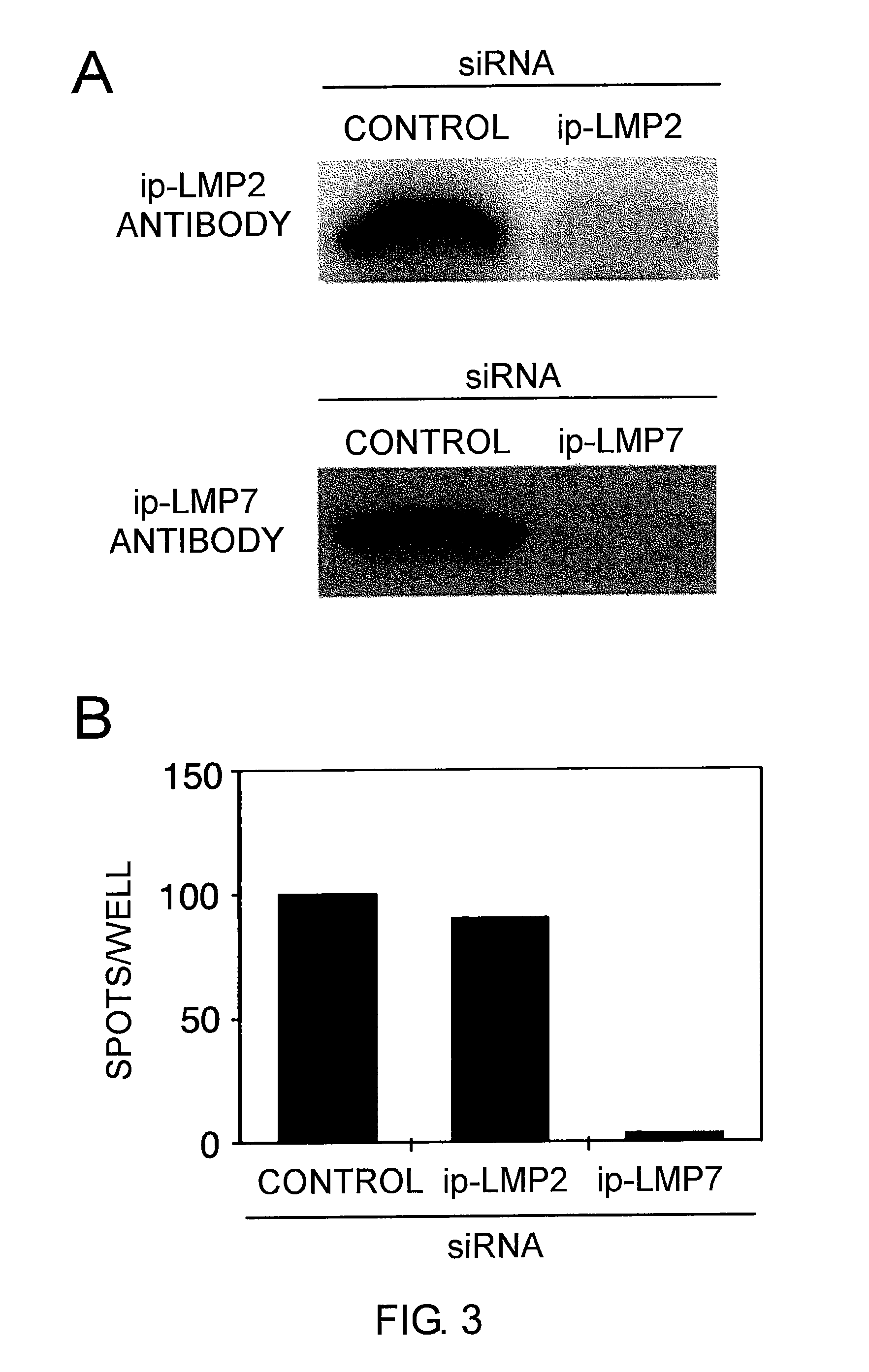Cytotoxic T-cell epitope peptides that specifically attack epstein-barr virus-infected cells and uses thereof
a cytotoxic, t-cell technology, applied in the field of cytotoxic t-cell epitope peptides, can solve the problem that such nk/t cells cannot process lmp1 and have not been demonstrated
- Summary
- Abstract
- Description
- Claims
- Application Information
AI Technical Summary
Benefits of technology
Problems solved by technology
Method used
Image
Examples
example 1
Preparation of Cell Strains and Dendritic Cells
[0234]The present inventors first induced CTL clones specific to LMP1, an EBV protein, and identified LMP1-derived epitopes.
[0235]The cell strains and dendritic cells used in the experiments for identifying LMP1-derived epitopes (Examples 1 to 8) were prepared by the following methods.
[0236]The study design and purpose, which had been approved by the institutional review board of Aichi Cancer Center (Japan), were fully explained and informed consents were obtained from all the donors.
[0237]EBV-infected LCLs were prepared by known methods (Kuzushima K., et al., Blood, 94:3094-3100 (1999)) and cultured in RPMI1640 medium (Sigma Chemical Co., St. Louis, Mo., USA) supplemented with 10% fetal calf serum (PAA laboratories, Pasching, Austria), 2 mM L-glutamine, 50 U / mL penicillin, 50 μg / mL streptomycin, and 50 μg / mL kanamycin.
[0238]EBV-carrying NK cell lines, SNK-6 (Nagata H., et al., Blood, 97:708-713 (2001)), and SNK-10 (Zhang Y., et al., Br...
example 2
Preparation of Deletion Mutant ΔLMP1 mRNA
[0244]To generate deletion mutant ΔLMP1-expressing antigen-presenting cells, the present inventors first produced deletion mutant ΔLMP1 mRNA by using an in vitro transcription system from the pcDNA / ΔLMP1 plasmid.
[0245]To construct a 43-amino acid N-terminal deletion mutant, ΔLMP1 (Gottschalk S., Blood, 101: 1905-1912 (2003)), PCR was performed using a sense primer 5′-AAGCTTGCCACCATGAGTGACTGGACTGGA-3′ (SEQ ID NO: 23), an antisense primer 5′-TTGAATTCTTAGTCATAGTAGCTTAGCTGA-3′ (SEQ ID NO: 24), and EBV strain B95-8 (NCBI accession no. V01555) cDNA as a template. The amino acid sequence and the oligonucleotide sequence of the deletion mutant ΔLMP1 are shown as SEQ ID NOs: 34 and 35, respectively. The resultant DNA fragment was cloned into pcDNA 3.1(+) (Invitrogen, Carlsbad, Calif., USA) using its HindIII and EcoRI restriction enzyme recognition sites (pcDNA / ΔLMP1). For constructing further C-terminal and N-terminal deletion mutants of the ΔLMP1, tr...
example 3
Transduction of ΔLMP1 mRNA into Cells and Verification of ΔLMP1 Expression in Cells
[0248]Fragments comprising the T7 promoter region and the ΔLMP1 coding region were prepared by PCR using pcDNA / ΔLMP1 as a template. The amplified DNA was used as a template for in vitro transcription of 5′-capped mRNA. The in vitro transcription of 5′-capped mRNA was performed using a mMESSAGE mMACHINE kit (Ambion, Austin, Tex., USA).
[0249]The 3′ polyA tail was added using polyA polymerase (Ambion) followed by purification with an RNeasy kit (Qiagen, Tokyo Japan).
[0250]Prior to electroporation, the dendritic cells and CD40-B cells were washed twice with serum-free RPMI1640 medium and adjusted to a final concentration of 2.5×107 cells / mL. The cells in 40 μL RPMI 1640 medium were mixed with 20 μg of mRNA, and electroporated in a 2 mm cuvette using an Electro Square Porator ECM 830 (Harvard Apparatus, Holliston, Mass.). The conditions were 450 V and 500 μS for dendritic cells and 350 V and 350 μS for CD4...
PUM
| Property | Measurement | Unit |
|---|---|---|
| concentration | aaaaa | aaaaa |
| concentration | aaaaa | aaaaa |
| frequency | aaaaa | aaaaa |
Abstract
Description
Claims
Application Information
 Login to View More
Login to View More - R&D
- Intellectual Property
- Life Sciences
- Materials
- Tech Scout
- Unparalleled Data Quality
- Higher Quality Content
- 60% Fewer Hallucinations
Browse by: Latest US Patents, China's latest patents, Technical Efficacy Thesaurus, Application Domain, Technology Topic, Popular Technical Reports.
© 2025 PatSnap. All rights reserved.Legal|Privacy policy|Modern Slavery Act Transparency Statement|Sitemap|About US| Contact US: help@patsnap.com



